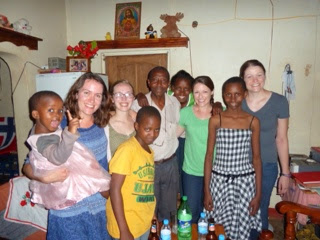We've also been lucky enough to meet other medical & nursing students from all over the world, as well as a few American residents and med students we wouldn't otherwise have met.
Our house on the doctor's compound happens to be inhabited only by Americans since we've been here. Chris, a 4th year student from Mizzou, was the only one home when we arrived and was super helpful in finding our way around, giving tips on places to get internet and how to use our Vodacom phones, and introducing us to some of the other students. Marianna returned from a Kilimajaro climb a week into our stay, and just left for home last week after a 3 month stay. With Chris now on his own Kili climb it's been a bit quiet around here lately.
Our roommates on our last pizza & beer outing before they left (above, left) and out in town on Marianna's last night (above, right).
We've also made friends from all over the world. Our neighbors on this street were from Wales and Sweeden, and we spent quite a bit of time exploring with them. The Welsh girls turned out to be excellent hostesses and cooks, planing a potluck for the international and Tanzanian students last week which was quite impressive.
Here's just part of the spread:
And a picture of all 6 of us girls:
The month wouldn't have been the same without these and so many more wonderful people we've met here. I miss them already!


















